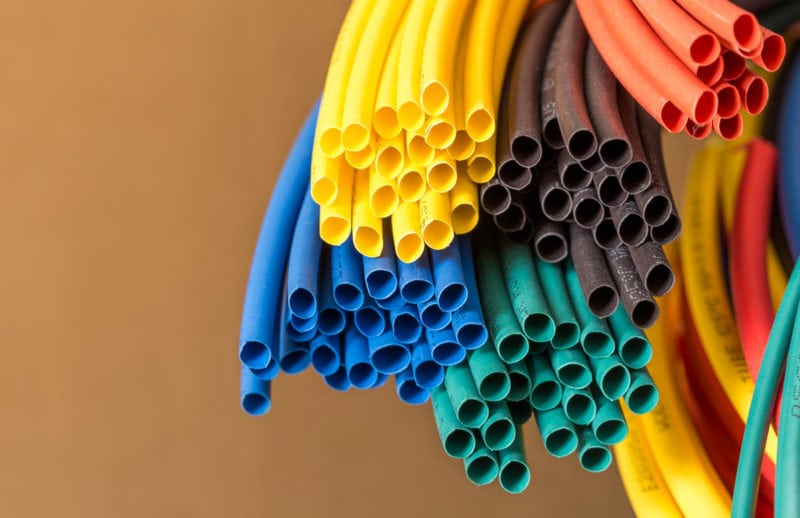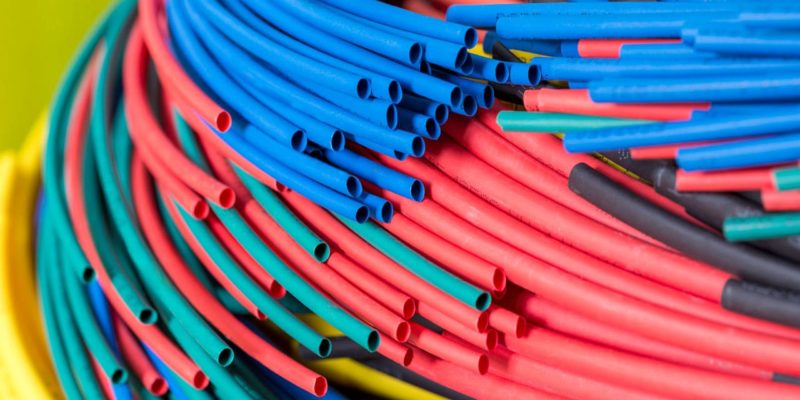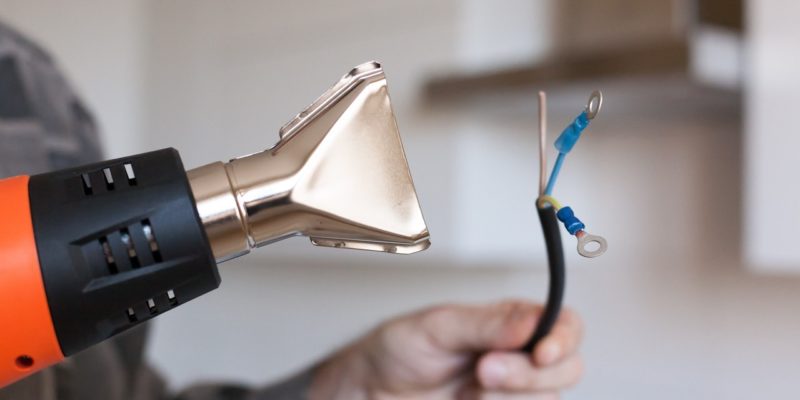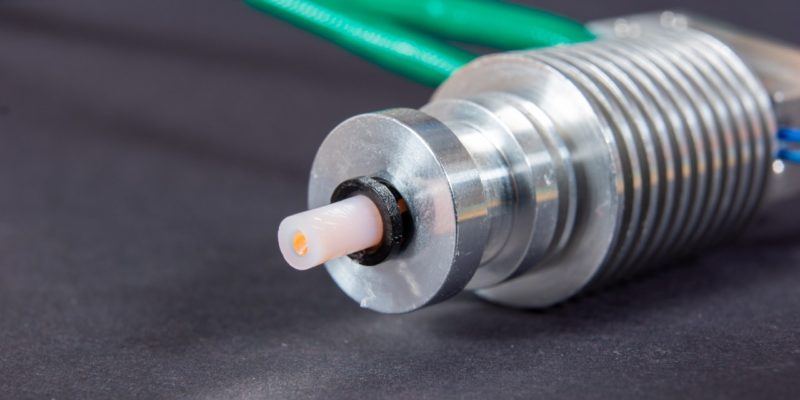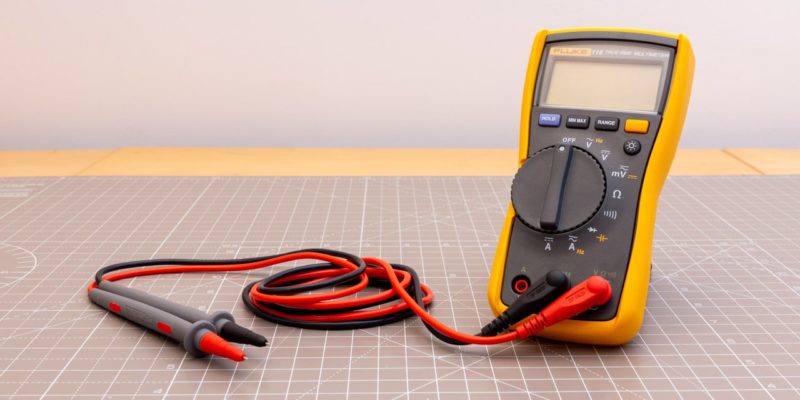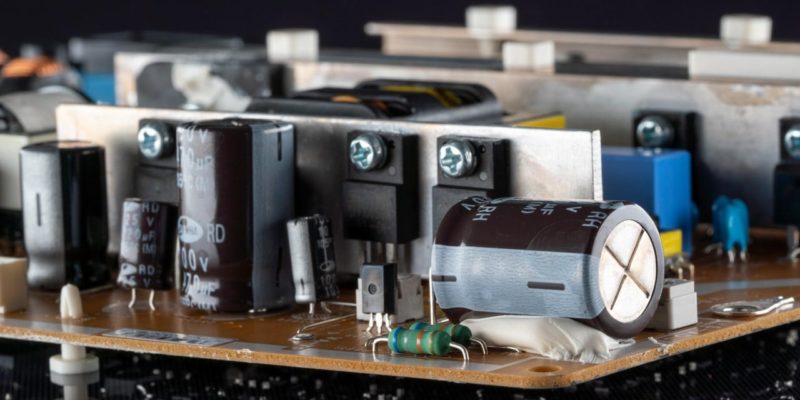Heat shrink tubing and electrical tape are both widely used for insulating, protecting and bundling wires. Because of their similar qualities, it is easy to assume that they can be blindly interchanged.
This is not the case, however. The two products have several prominent differences. Depending on your project or application, you might want to use one instead of the other.
In this article I will compare the two, go over their benefits and drawbacks, and share when they are best used.
Let’s see whether using heat shrink tubing or electrical tape is best for your project!
What is Heat Shrink Tubing?
Heat shrink tubing is a type of plastic tube that shrinks when sufficiently heated. This allows it to form a tight, custom fit over a variety of components. It is most commonly used on wires, cables and connectors.
Heat shrink can be made from a variety of materials. Due to their low cost and versatility, Polyolefin and PVC are the most popular. Other materials include PTFE, PVDF, FEP, Silicone and Viton.
When heated, shrink tubing shrinks in size based on a predetermined ratio, such as 2:1 or 3:1.
What are the Benefits of Heat Shrink Tubing?
Heat shrink tubing comes with a wide range of benefits, making it an extremely versatile product. These are the most notable ones.
- It provides electrical insulation.
- It protects against dust, solvents and moisture.
- It holds wires together.
- It adds strain relief.
- It creates a physical layer of protection against abrasion and other sources of physical damage.
- It allows for the color coding of wires.
Compared to other insulation methods, it gives you a more professional looking final result, often at a lower cost.
All in all, these advantages make heat shrink a great option for insulation, protection, repairs and preventative maintenance.
What is Electrical Tape?
Electrical tape is an adhesive-backed, pressure sensitive tape that is typically made of vinyl, rubber or mastic (a plant resin). Just like heat shrink, you can apply it to wires and other conductors for electrical insulation and environmental protection.
Electrical tape is usually black, but it also comes in other colors. Black electrical tape is typically used by electricians for insulation, repairs and wire bundling, whereas colored electrical tape is applied to wires to indicate the presence of certain voltages or phases.
What are the Benefits of Electrical Tape?
- It is quick and easy to apply.
- It is very flexible.
- It electrically insulates.
- It bundles wires.
- It can be used for color coding.
The first two advantages in this list, the ease of use and flexibility, are the most significant strengths of electrical tape. Applying electrical tape only takes seconds and does not require the need of other tools. This makes it a great option for emergency repairs, where access to tools is often limited and time is critical.
Because of its flexibility, electrical tape can be stretched to cover many different objects, sizes and shapes.
Limitations of Electrical Tape
The main limitation of electrical tape is its limited durability. Over time, it loses its adhesiveness and falls from the object it was attached to. At that point, it does not electrically insulate or protect anymore, which is obviously a problem.
Electrical tape slowly deteriorates on its own, but this process accelerates when the tape is exposed to high heat, environmental factors (wind, rain, snow, etc.) or corrosive chemicals. Abrasion and friction are a problem as well.
Depending on the application, you can often see a clear difference in the condition of electrical tape after only months or weeks of use.
Because of these limitations, it is important to frequently check on the condition of electrical tape. It is inevitable that it comes off at some point. When it does, it needs to be replaced.
Needless to say, checking on tape is not a great use of your time. This is one of the reasons why electrical tape is only recommended as a temporary measure.
How Do Heat Shrink Tubing and Electrical Tape Compare?
As you have seen above, heat shrink tubing and electrical tape have several qualities in common. They insulate well and both are good solutions for wire bundling and color coding. They also have several differences, however. Because of these, heat shrink and electrical tape are best suited for different applications.
Because heat shrink has a fixed shrink ratio, it is able to form a tighter fit around components than electrical tape can. With adhesive-lined tubing with a high shrink ratio (3:1 or more), you can even form waterproof seals. This is something that regular electrical tape can not do, no matter how many layers you apply.
In terms of durability, heat shrink tubing is a clear winner too. The adhesive on electrical tape lets go after a while, requiring it to be reapplied. And that is without factoring in exposure to any abrasion or chemicals.
Heat shrink tubing can be made of significantly more different materials. This makes it relatively easy to find heat shrink that matches the exact needs of your project. If you need your insulation to hold up to strong UV radiation or extreme temperatures, shrink tubing lets you do so.
Electrical tape is not all bad, however. It is more flexible than heat shrink and lets you insulate oddly-shaped components that heat shrink does not fit over.
You can also apply it within seconds, without the use of a heat gun or a different heat source. When time is of the essence, nothing beats electrical tape.
As for pricing, heat shrink tends to be cheaper. Especially when factoring in the (lack of) costs of replacing it once every while, like you would have to do with electrical tape.
In summary
Heat shrink tubing
- forms a tighter fit
- is significantly more durable
- comes in more materials
- deals better with abrasion
- gives proper protection against chemicals and environmental factors
- can form waterproof connections (with the adhesive-lined variant)
- looks better
- is cheaper
Electrical tape
- is more flexible
- is quicker to apply
- does not require other tools to apply
- can be applied after terminating a connection
When to Use Heat Shrink and When to Use Electrical Tape
For applications where you need permanent insulation, you should use heat shrink tubing. For temporary fixes, electrical tape works fine. Just be sure to replace it with something permanent as soon as you can. Its lack of durability means that electrical tape is not a long-term solution for anything.
The Best Electrical Tape
There are significant differences in quality between cheap electrical tape and the good stuff. The ‘gold standard’ is 3M Vinyl Super 88 Electrical Tape. It provides insulation up to 600V and deals relatively well with weather and UV exposure, all while not costing an arm and a leg.
Alternatives to Electrical Tape
As you probably have realized by now, a quality heat shrink kit is the best alternative to electrical tape. But there are other options out there that work better for certain applications.
One of these options is self-fusing tape. Also known as self-amalgamating tape, it forms a strong, seamless and waterproof seal after application. It does this by fusing with itself into a permanent solid mass. It is ideal for adding a durable, impenetrable layer to cables, hoses, and electrical joints.
It is on the pricy side, but if you need a long-lasting (10+ years) protective seal on something, this tape lets you do so. Just be careful, once you apply it, it is very hard to get off again.
Conclusion
When comparing heat shrink tubing and electrical tape, there is no doubt that heat shrink is the clear winner. They are fairly similar in insulation qualities, wire bundling and color coding, but that’s where the equivalence stops.
Heat shrink protects better against harsh weather and chemicals, forms a better seal and does not come off on its own or due to friction. It is important to pick the right size of tubing, however, but that is fairly easy to do with a variety kit.
Electrical tape is still a valid option if you are in a pinch and do not have anything else at hand. It is easy to apply, insulates well and lasts long enough for you to find something better to replace it with. Just make sure to get quality electrical tape instead of the cheap stuff that does not stick to anything and that is not UL certified.
If you are looking for an insulating tape that forms waterproof seals and does not ever come off, self-amalgating tape is what you should be looking at. Once fused, it forms a solid, impermeable block of rubber. It works well for sealing oddly shaped electrical joints that heat shrink does not fit around.



